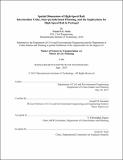| dc.contributor.advisor | Joseph M. Sussman. | en_US |
| dc.contributor.author | Stein, Naomi E. G. (Naomi Elizabetg Geisler) | en_US |
| dc.contributor.other | Massachusetts Institute of Technology. Department of Urban Studies and Planning. | en_US |
| dc.coverage.spatial | e-po--- | en_US |
| dc.date.accessioned | 2013-12-06T19:52:17Z | |
| dc.date.available | 2013-12-06T19:52:17Z | |
| dc.date.copyright | 2013 | en_US |
| dc.date.issued | 2013 | en_US |
| dc.identifier.uri | http://hdl.handle.net/1721.1/82723 | |
| dc.description | Thesis (M.C.P. in Transportation)--Massachusetts Institute of Technology, Department of Urban Studies and Planning, 2013. | en_US |
| dc.description | This electronic version was submitted by the student author. The certified thesis is available in the Institute Archives and Special Collections. | en_US |
| dc.description | Cataloged from student-submitted PDF version of thesis. | en_US |
| dc.description | Includes bibliographical references. | en_US |
| dc.description.abstract | Globalization has magnified the role of regions, restructuring social and economic relationships into networks that span increasing distances. At the same time, greater attention is paid to urban quality, as non-vehicular modes and compact forms of development become critical in an environmentally conscious world. Within this context, increasing interest and adoption of high-speed rail (HSR)-- mode with spatial sustainability objectives--is unsurprising. HSR has the potential to integrate cities into mutually supportive networks across long distances while also supporting more sustainable forms of development. For HSR to become a sustainable investment, however, requires coordinated policy efforts across levels of government and at different points in a project's life-cycle. This investigation spans multiple scales of the physical environment and institutional sphere, examines ways of coupling institutional change with technological change, and addresses the importance of uncertainty as a driver of system behavior. We focus on inter-jurisdictional relationships, with special attention paid to smaller intermediate cities brought within one-hour's travel time of a larger metropolis by HSR services. Mid-distance service (<250 km) has strong spatial implications and can expand connections to the scale of new discontinuous regions--single labor and commercial markets that spans long distances but do not include all intermediate areas. Both Portugal and the United Kingdom (UK) are planning HSR systems that will provide mid-distance service. Through stakeholder interviews and a critical reading of the literature, this thesis develops a theory-based assessment of goals for regional restructuring, studies existing and planned Portuguese rail-commuter-cities, and compares HSR planning in Portugal and the UK. We see evidence that HSR can induce new ways of thinking about urbanization, regional connectivity, and governance. The scope of change that might be put into effect by HSR creates greater incentives for collaboration than those that normally exist. We find that local knowledge and policy will improve HSR design and implementation by helping to ensure smooth interfaces between HSR and existing urban mobility systems. Developing decision-making structures that will work across geographic scales and sectors of government, and long-term uncertainty, will be critical in helping HSR achieve 3E--Economic, Environmental and Equitable--sustainability. | en_US |
| dc.description.statementofresponsibility | by Naomi E. G. Stein. | en_US |
| dc.format.extent | 204 pages | en_US |
| dc.language.iso | eng | en_US |
| dc.publisher | Massachusetts Institute of Technology | en_US |
| dc.rights | M.I.T. theses are protected by
copyright. They may be viewed from this source for any purpose, but
reproduction or distribution in any format is prohibited without written
permission. See provided URL for inquiries about permission. | en_US |
| dc.rights.uri | http://dspace.mit.edu/handle/1721.1/7582 | en_US |
| dc.subject | Urban Studies and Planning. | en_US |
| dc.title | Spatial dimensions of high-speed rail : intermediate cities, inter-jurisdictional planning, and the implications for high-speed rail in Portugal | en_US |
| dc.title.alternative | Intermediate cities, inter-jurisdictional planning, and the implications for high-speed rail in Portugal | en_US |
| dc.type | Thesis | en_US |
| dc.description.degree | M.C.P.in Transportation | en_US |
| dc.contributor.department | Massachusetts Institute of Technology. Department of Urban Studies and Planning | |
| dc.identifier.oclc | 864005542 | en_US |
